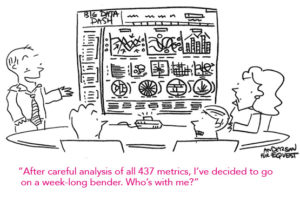Research and Measurement: Art Meets Science

When someone recently asked me to explain my approach to research and measurement, my response (typical of a researcher) was “could you be more specific?” The question seemed overwhelming – akin to asking a surgeon to explain her approach to surgery or a composer to explain his approach to writing a symphony.
Of course, I don’t think research is on the same level as surgery or musical composition. However, I do see research as a combination of art and science. It is where human meets machine, and it is the marriage of insight and data.
I suppose this outlook on research forms the building blocks of an approach, and when considered in this light, my approach is fairly simple. It hasn’t wavered in 20+ years in this business. It holds true for measurement/media analysis, or for more advanced research, such as luminary intelligence, competitive intelligence, and industry analysis. It is fitting for both traditional media, and the new world order of paid, earned, shared, and owned. The end product or metrics might change, but the fundamental approach does not.
Start by Listening (and clarifying)
One of the first things I learned in library school was the skill of the research interview. It is a skill that I still apply to every project. It is easy to forget this step and to take a research request at face value. Yet experience has taught me that people don’t always ask for what they really want. Maybe they are not exactly sure what they want, don’t have the right terminology to express what they want, or ask for research that they mistakenly believe will get them what they want. A two-way dialogue is critical in order to understand the intentions behind the research. Ultimately, the most important question I can ask is “what do you want to do with this information?” This question cuts straight to the chase and reveals the underlying business goal.
Map and Customize Research to Goals
For research or measurement to be of value, it must be tied to the specific goals of the communications program, which in turn should map to the business goals – what senior leaders expect the marketing communications program to do for the business. I try at all times to avoid the temptation to succumb to vanity metrics or to follow a prescribed research formula. That would be a disservice to our clients. There is no one-size-fits-all approach to research and measurement, and this is one reason that automated tools are not enough.
Fuse Human Analysis with Technology and Tools
I rely on technology, and while I could not do my job without it, I have yet to meet a machine that can replace human expertise. This is perhaps why the role of the data scientist has become so emergent in the last several years. I do not believe in taking a report that has been automatically generated by an analytics tool and passing it off to a client as research. Having spent time in house at an analytics vendor, I know first-hand where gaps are likely to exist in knowledge and accuracy. I use automated tools to gather information and data, but then I layer human judgement and analysis on top of that data.
Provide Actionable Insight (not a data dump)
Human analysis can provide what data alone cannot – insight. Insight has been defined as “the capacity to gain an accurate and deep understanding of someone or something.” With a deep and accurate understanding of a company’s performance, their competitors, and the market landscape, we can develop the correct strategy to move their brand forward. Data without insight is essentially useless, what we referred to in the early days of research as a “data dump.” It’s the valuable combination of data + insight that research should deliver.
Incorporate Research into the Program Lifecycle
Ad hoc projects can provide value, but in an ideal world, research is not a random occurrence. It should not exist in a vacuum but should instead be continuously integrated into the marketing program lifecycle. Begin, for instance, with a competitive messaging analysis to create differentiated messaging. Next, perform research to uncover new channels and influencers who can help disseminate the message. Implement measurement to determine if messaging is effective and if it is resulting in greater brand recognition. Take those insights, adjust strategy and tactics, and then measure again. This is one example of how research can be woven into the fabric of the marketing program.
Essentially, research and measurement is about unlocking mysteries – in our work, those are mysteries about a business or market. As Albert Einstein said, “The most beautiful thing we can experience is the mysterious. It is the source of all true art and science.”
Thea Roberti is Chief Research Analyst at Offleash and is widely regarded in Silicon Valley as an expert research analyst. She provides competitive analysis, industry research, media, social and marketing channel analysis, and influencer research to Offleash clients across a wide range of enterprise technologies. Contact Thea here.
Subscribe to our newsletter.